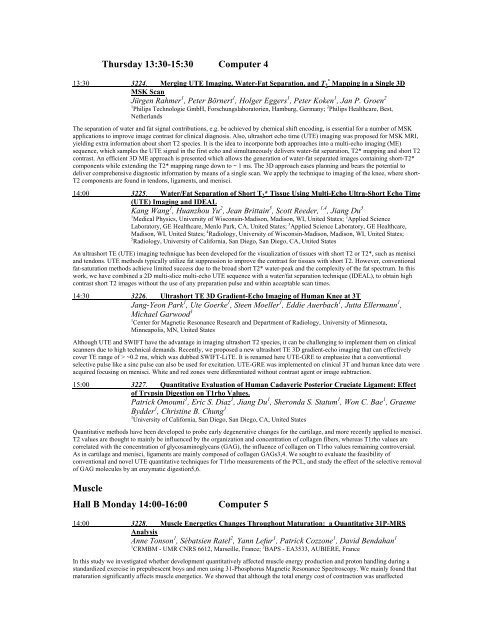ELECTRONIC POSTER - ismrm
ELECTRONIC POSTER - ismrm
ELECTRONIC POSTER - ismrm
You also want an ePaper? Increase the reach of your titles
YUMPU automatically turns print PDFs into web optimized ePapers that Google loves.
Thursday 13:30-15:30 Computer 4<br />
13:30 3224. Merging UTE Imaging, Water-Fat Separation, and T 2 * Mapping in a Single 3D<br />
MSK Scan<br />
Jürgen Rahmer 1 , Peter Börnert 1 , Holger Eggers 1 , Peter Koken 1 , Jan P. Groen 2<br />
1 Philips Technologie GmbH, Forschungslaboratorien, Hamburg, Germany; 2 Philips Healthcare, Best,<br />
Netherlands<br />
The separation of water and fat signal contributions, e.g. be achieved by chemical shift encoding, is essential for a number of MSK<br />
applications to improve image contrast for clinical diagnosis. Also, ultrashort echo time (UTE) imaging was proposed for MSK MRI,<br />
yielding extra information about short T2 species. It is the idea to incorporate both approaches into a multi-echo imaging (ME)<br />
sequence, which samples the UTE signal in the first echo and simultaneously delivers water-fat separation, T2* mapping and short T2<br />
contrast. An efficient 3D ME approach is presented which allows the generation of water-fat separated images containing short-T2*<br />
components while extending the T2* mapping range down to ~ 1 ms. The 3D approach eases planning and bears the potential to<br />
deliver comprehensive diagnostic information by means of a single scan. We apply the technique to imaging of the knee, where short-<br />
T2 components are found in tendons, ligaments, and menisci.<br />
14:00 3225. Water/Fat Separation of Short T 2 * Tissue Using Multi-Echo Ultra-Short Echo Time<br />
(UTE) Imaging and IDEAL<br />
Kang Wang 1 , Huanzhou Yu 2 , Jean Brittain 3 , Scott Reeder, 1,4 , Jiang Du 5<br />
1 Medical Physics, University of Wisconsin-Madison, Madison, WI, United States; 2 Applied Science<br />
Laboratory, GE Healthcare, Menlo Park, CA, United States; 3 Applied Science Laboratory, GE Healthcare,<br />
Madison, WI, United States; 4 Radiology, University of Wisconsin-Madison, Madison, WI, United States;<br />
5 Radiology, University of California, San Diego, San Diego, CA, United States<br />
An ultrashort TE (UTE) imaging technique has been developed for the visualization of tissues with short T2 or T2*, such as menisci<br />
and tendons. UTE methods typically utilize fat suppression to improve the contrast for tissues with short T2. However, conventional<br />
fat-saturation methods achieve limited success due to the broad short T2* water-peak and the complexity of the fat spectrum. In this<br />
work, we have combined a 2D multi-slice multi-echo UTE sequence with a water/fat separation technique (IDEAL), to obtain high<br />
contrast short T2 images without the use of any preparation pulse and within acceptable scan times.<br />
14:30 3226. Ultrashort TE 3D Gradient-Echo Imaging of Human Knee at 3T<br />
Jang-Yeon Park 1 , Ute Goerke 1 , Steen Moeller 1 , Eddie Auerbach 1 , Jutta Ellermann 1 ,<br />
Michael Garwood 1<br />
1 Center for Magnetic Resonance Research and Department of Radiology, University of Minnesota,<br />
Minneapolis, MN, United States<br />
Although UTE and SWIFT have the advantage in imaging ultrashort T2 species, it can be challenging to implement them on clinical<br />
scanners due to high technical demands. Recently, we proposed a new ultrashort TE 3D gradient-echo imaging that can effectively<br />
cover TE range of > ~0.2 ms, which was dubbed SWIFT-LiTE. It is renamed here UTE-GRE to emphasize that a conventional<br />
selective pulse like a sinc pulse can also be used for excitation. UTE-GRE was implemented on clinical 3T and human knee data were<br />
acquired focusing on menisci. White and red zones were differentiated without contrast agent or image subtraction.<br />
15:00 3227. Quantitative Evaluation of Human Cadaveric Posterior Cruciate Ligament: Effect<br />
of Trypsin Digestion on T1rho Values.<br />
Patrick Omoumi 1 , Eric S. Diaz 1 , Jiang Du 1 , Sheronda S. Statum 1 , Won C. Bae 1 , Graeme<br />
Bydder 1 , Christine B. Chung 1<br />
1 University of California, San Diego, San Diego, CA, United States<br />
Quantitative methods have been developed to probe early degenerative changes for the cartilage, and more recently applied to menisci.<br />
T2 values are thought to mainly be influenced by the organization and concentration of collagen fibers, whereas T1rho values are<br />
correlated with the concentration of glycosaminoglycans (GAG), the influence of collagen on T1rho values remaining controversial.<br />
As in cartilage and menisci, ligaments are mainly composed of collagen GAGs3,4. We sought to evaluate the feasibility of<br />
conventional and novel UTE quantitative techniques for T1rho measurements of the PCL, and study the effect of the selective removal<br />
of GAG molecules by an enzymatic digestion5,6.<br />
Muscle<br />
Hall B Monday 14:00-16:00 Computer 5<br />
14:00 3228. Muscle Energetics Changes Throughout Maturation: a Quantitative 31P-MRS<br />
Analysis<br />
Anne Tonson 1 , Sébatsien Ratel 2 , Yann Lefur 1 , Patrick Cozzone 1 , David Bendahan 1<br />
1 CRMBM - UMR CNRS 6612, Marseille, France; 2 BAPS - EA3533, AUBIERE, France<br />
In this study we investigated whether development quantitatively affected muscle energy production and proton handling during a<br />
standardized exercise in prepubescent boys and men using 31-Phosphorus Magnetic Resonance Spectroscopy. We mainly found that<br />
maturation significantly affects muscle energetics. We showed that although the total energy cost of contraction was unaffected
















